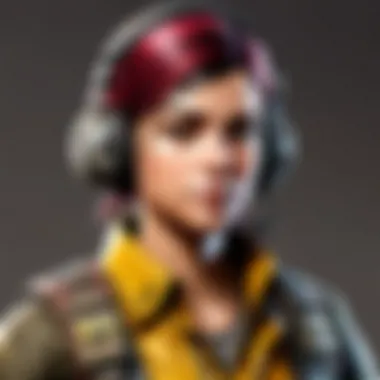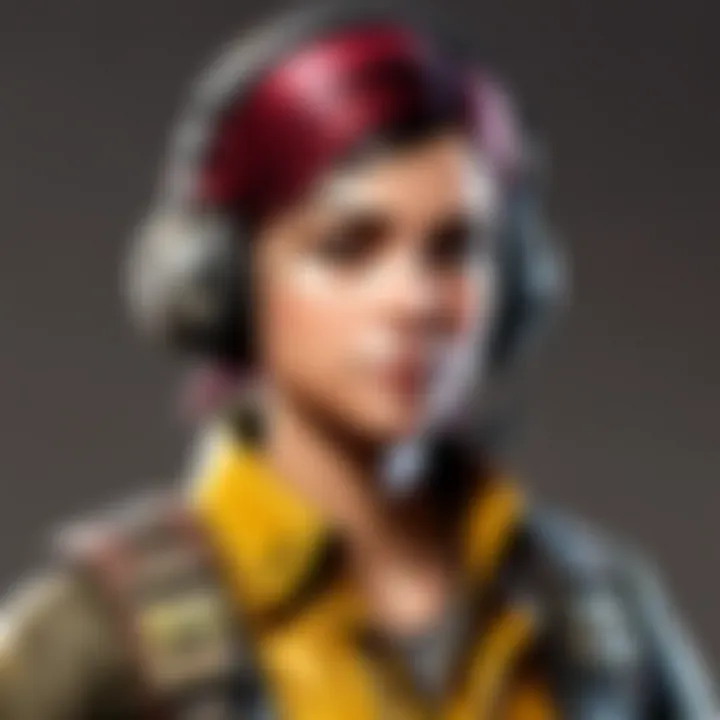Exploring Gaming's Push to Talk Buttons for Teamwork


Intro
In the ever-expanding realm of gaming, communication often serves as the invisible thread that stitches together individual players into cohesive teams. The dynamics of gameplay can shift with a simple command or a strategic placement of words. This is particularly evident in games like PlayerUnknown’s Battlegrounds, commonly known as PUBG. Here, the use of push-to-talk buttons has emerged as a crucial feature that enhances player interaction and teamwork.
Understanding the role of push-to-talk buttons in gaming is more than just diving into how they work; it’s about grasping how they reshape gameplay experiences. These buttons offer players immediate means to convey critical information without the chaos of open mic chatter. Balance, strategy, and efficiency often hinge on effective communication, making these tools indispensable. As we explore further, let's highlight the myriad ways push-to-talk buttons influence nuances in the gaming world and examine practical tips to maximize their use effectively.
Game Updates
In the dynamic landscape of gaming, staying updated is essential. As developers continually refine systems, the integration of new features specifically concerning communication tools like push-to-talk buttons deserves close attention. The latest updates in games such as PUBG pave the way for improved user experiences and set the standard for how players can collaborate.
Patch notes & changes
Recent patch notes often include changes that enhance the functionality of push-to-talk systems. These patches may introduce improved latency, allowing players to deliver commands with greater immediacy. Some updates also tweak the button configurations to accommodate diverse playstyles. Players’ feedback shapes these updates, emphasizing the need for seamless interaction among teammates.
New features & additions
Among the new features, voice customization options are particularly noteworthy. Players can adjust the voice modulation to suit their preferences, making the communication experience unique. Additionally, some updates have explored integrating voice chat functions deeper within the game, allowing for intuitive command issuance and situational awareness. All these new aspects gather momentum and enhance overall engagement within the game.
Bug fixes & improvements
Games aren’t without their share of bugs, and push-to-talk systems sometimes face their fair share. Scheduled improvements often target known issues such as button responsiveness and error messages. Timely bug fixes ensure that players can rely on these critical communication tools during intense gameplay, preserving the integrity of competitive play.
Effective communication is often the secret sauce that distinguishes winning teams from the rest.
With these updates, players can adapt more efficiently, making decisions faster and more accurately based on shared intel. In the next sections, we’ll delve deeper into strategy guides, exploring how push-to-talk buttons enhance gameplay tactics and team synergy.
Strategy Guides
When it comes to playing PUBG, the synergy between team strategies and push-to-talk buttons cannot be overstated. Effective communication elevates individual skills into a combined effective strategy that can dominate the map. Here are some essential tactics to develop a strong rapport with your team.
Map-specific tactics
Familiarity with the various maps in PUBG can fortify tactics. Coordinating drops, loot gathering, and positioning can hinge on how well players communicate. For instance, on Erangel, when dropping into Pochinki, vocal commands are vital. Players must decide whether to stick together or split to cover more ground for resources early on.
Weapon loadout recommendations
Communicating weapon preferences can also enhance team efficiency. Consider this, one player might prefer an M4A1 while another opts for a sniper rifle. Using push-to-talk to quickly relay these preferences can unify the team’s strategy around shared perspective, increasing survival chances in gunfights.
Survival tips & tricks
Listening to teammates during intense combat situations can save lives. When one player is under fire, calling for assistance through push-to-talk can create a sense of urgency and prompt immediate action. Regular training on using these buttons effectively can enhance team coordination and survival rates in skirmishes.
By mastering these strategies, players not only become adept at navigating gameplay but also build a camaraderie that transcends virtual boundaries. The next section will focus on the competitive scene and how effective communication can influence outcomes in esports.
Prelims to Push to Talk in Gaming
Understanding communication in gaming has never been more crucial. Push to Talk (PTT) functionality is a key aspect that every player should grasp. This feature allows for a smoother interaction between teammates, ensuring strategies link up seamlessly during gameplay, especially in fast-paced environments like PUBG.
Defining Push to Talk


Push to Talk is essentially a feature that enables players to transmit voice messages by pressing a designated button or key. This nifty little tool allows for real-time communication, where players can coordinate moves without the chaos of constant chatter filling the airwaves. Think of it as having a walkie-talkie—you only speak when you need to, keeping conversations focused and relevant. For example, pressing the key to alert your team of an enemy sighting can be much more effective than having every voice chiming in at once, making communication clear and efficient.
Historical Context of In-Game Communication
To fully appreciate Push to Talk, let’s rewind the clock a bit. When gaming first hit the mainstream, players relied on text chat to communicate. Early games had basic messaging options, where typing was the only way to relay information. This often led to misunderstandings and missed opportunities, as players had to pause their actions to type messages.
As gaming evolved, voice chat emerged as a game changer. Initially, it required additional tools and platforms, where players logged onto external services like Ventrilo or TeamSpeak. While these platforms were revolutionary, they came with their set of problems, including latency and user management issues.
Then came Push to Talk—an elegant solution to the cluttered communication chaos. By integrating it within games, developers allowed players to relay important information hands-free while gaming. This huge leap made in-game communication more accessible and intuitive. PTT set the stage for enhanced cooperation in titles like PUBG, where strategy and swift communication can make or break a match.
The Mechanics of Push to Talk
Understanding how push to talk (PTT) systems work is vital for any serious gamer. While seemingly straightforward, these tools represent the backbone of efficient communication during gameplay. It's not just about pressing a button; it involves a seamless fusion of technology and user experience that can heavily influence team dynamics and overall performance.
Push to talk systems function by allowing players to transmit their voice to teammates only when a button is held down. This means that communication is controlled, reducing background noise and confusion within the game. By activating the mic only during actual talking times, players can maintain focus, listen carefully, and react to in-game events without disturbances. It’s a game-changer in fast-paced environments.
How Push to Talk Works
At its core, the mechanics of push to talk revolve around the simple act of modifying audio input based on user interaction. For example, when a player presses the assigned key, the game automatically activates the microphone feed, allowing for clear audio transmission.
- Hardware Interaction: The player's hardware, which includes a microphone and headphones, plays a significant role. Good quality microphones filter out ambient sounds, ensuring that team members hear each other distinctly, despite noisy backgrounds.
- Software Configuration: The gaming platform typically features built-in settings for configuring push to talk options. Setting the right keybinding to suit one's playstyle can significantly affect comfort and efficiency. For instance, binding the function to a finger that’s readily accessible while playing can yield smoother communication.
- Latency Considerations: An often overlooked aspect is latency. The responsiveness of both the hardware and the software can impact how quickly sound transmits. Effective push to talk systems minimize delay, allowing players to react promptly without slurring speech. If latency is significant, it may lead to frustration and miscommunication amongst teammates.
- Microphone Sensitivity: Being careful about microphone settings can ensure that voices are captured cleanly. Depending on the gaming environment, players might want to adjust sensitivity to filter out accidental noises or to be heard clearly.
In summary, the mechanics of push to talk aren’t as simple as pushing a button. There’s a complex interplay of hardware settings, software configurations, and human factors that contribute to its efficiency in enhancing communication. Players should familiarize themselves with their devices and the game’s options to ensure they’re getting the best use out of their setup.
Integration with Gaming Platforms
Push to talk systems are more than just useful; they are essential for modern gaming platforms. To truly grasp their value, one must look at how they integrate seamlessly into various gaming ecosystems. Most popular platforms like Steam, Discord, and Xbox Live come equipped with push to talk functionalities that can be customized by the user.
- Platform Compatibility: Push to talk features vary by platform. For instance, in Discord, players can set custom shortcuts and even have voice activation as an alternative to push to talk for those who prefer letters over buttons.
- Customization Options: Players can personalize these features based on their unique gaming styles. Custom binding allows for flexibility; most serious gamers will explore different options to find what feels right.
- Community Integrations: Much of the social interaction in gaming occurs in community-based platforms like Reddit or Facebook gaming streams, where push to talk enhances discussions, making it easier to relay strategies or coordinate during live games.
In essence, the integration of push to talk systems into gaming platforms underscores their necessity in enabling efficient communication across different gaming environments. As more games embrace this technology, players can expect even richer interactions and better teamwork experiences.
Benefits of Using Push to Talk
Understanding the advantages of using push to talk in gaming holds significant value for anyone diving into the intricate world of online play. For many players, effective communication can be the bedrock of success, especially in team-based games like PUBG. Push to talk systems offer distinct benefits, enhancing the player experience while addressing crucial aspects of in-game interaction. Here, we'll break down some of the main advantages.
Enhancing Team Communication
Communication is the lifeline of any successful gaming session. In competitive settings where quick decisions can lead to victories or defeats, having a reliable method to convey messages becomes paramount. Push to talk provides a structured way to communicate messages without the risk of unintentionally interrupting others. Players can convey information such as enemy locations, strategies, or health statuses in a timely manner. When each member of a team can utilize their microphone only when necessary, it fosters clearer exchanges.
- Players can coordinate tactics seamlessly.
- It reduces the likelihood of chaos with overlapping voices.
- Team members feel more engaged and invested in the gameplay.
Moreover, utilizing push to talk encourages a more focused approach to communication. Gamers must be deliberate with their words; thus, messages conveyed are often more succinct and impactful. This focused dialogue is crucial during intense moments when split-second decisions are required.
Reducing In-Game Distractions
Every gamer knows how easy it can be to lose focus in the fast-paced environment of online gaming. Background noise, idle chatter, or chaotic team banter can distract players from critical action. Push to talk effectively minimizes these potential disruptions. By activating the mic only when needed, players can silence their headsets when they aren’t speaking, contributing to a more immersive experience.
- Distraction-free environment encourages players to concentrate.
- Players can remain alert to in-game sounds, such as footsteps or gunfire.
- The reduction of audio clutter ensures that important calls do not get drowned out.


Additionally, with less ambient noise, players can develop a better sense of game rhythm and strategy. They can pick up on in-game cues that might normally be lost amid the din, leading to sharper reactions and smarter decisions on the battlefield.
Improving Overall Gameplay Experience
The overall gaming experience can be significantly elevated with the effective use of push to talk. Players find that with reduced distractions and enhanced communication, their enjoyment and satisfaction levels rise. Games become more than just competitive encounters; they evolve into cooperative challenges where every voice counts.
When players utilize push to talk, there are notable benefits such as:
- Increasing the feeling of team cohesion.
- Boosting morale as players enjoy better cooperation.
- Instilling confidence through clear communication channels.
The result? A more coherent experience that transforms not just how strategies are executed but also how players feel about the teams they are part of. Ultimately, mastering the use of push to talk not only leads to victories but also enriches the friendships and bonds formed during hours spent in the heat of battle.
Effective communication is not just useful; in gaming, it’s vital.
Push to Talk in Popular Games
The significance of push to talk functionality in popular games cannot be overstated. It serves as a cornerstone for effective communication, enabling players to strategize, coordinate, and respond swiftly to dynamic in-game situations. When players engage in complex scenarios, such as during a battle or while executing a well-timed attack, clear communication takes the front seat. The push to talk feature helps in minimizing the chaos that can upset game plans. Therefore, understanding how this tool is integrated within popular titles is crucial for players seeking to maximize their gaming experience.
Push to Talk in PUBG
In PlayerUnknown's Battlegrounds (PUBG), push to talk has become an indispensable aspect of gameplay. It allows players to communicate directly with teammates without broadcasting their conversations to every player in the vicinity. This becomes paramount in a game where positioning and stealth is key. By employing push to talk, players can share vital information, such as enemy locations or strategic plans, without tipping off opponents. Here’s how this functionality enhances PUBG:
- Tactical Coordination: Players can share real-time updates and enemy sightings to strategize movements or ambushes more effectively.
- Focus and Concentration: By limiting open mics, players reduce cluttered audio and focus on essential communications.
- Team Dynamics: Clear, actionable communication fosters better teamwork, which can lead to higher chances of survival and victory.
Comparison with Other Titles
While PUBG sets the bar high with its commendable use of push to talk, other titles have carved out their unique niches as well, adapting the feature to suit their distinct playstyles. Let’s delve into how push to talk functions across various popular games.
Fortnite
In Fortnite, the push to talk system mirrors aspects found in PUBG but comes with its flair. Players often team up to tackle challenges and engage in battles while building structures on the fly. This dynamic environment necessitates concise communication, and push to talk offers a practical solution. A key characteristic of Fortnite is its emphasis on cooperative gameplay, which makes push to talk beneficial during teamfights. Players can call out building positions or warn teammates of incoming threats without overwhelming the audio space. However, Fortnite sometimes requires players to adjust their mic settings frequently, which can be a tad cumbersome, especially in the heat of battle.
Call of Duty
Call of Duty games, renowned for their fast-paced combat, rely heavily on the push to talk feature to maintain team cohesion. The quick, reflex-based nature of these games means that having clear, rapid exchanges is vital. A standout aspect of Call of Duty is its proximity chat, which complements push to talk by allowing players to communicate based on spatial awareness. This feature adds a layer of strategy, enabling rival teams to overhear conversations if they are close enough. Nonetheless, while this can create tension, it can also lead to unintended betrayals if players are not cautious.
Apex Legends
In Apex Legends, push to talk is infused with the game's unique character abilities and squad-based mechanics. Communication is streamlined with a focus on character strengths and on-the-fly tactics. Players can complement verbal cues with in-game ping systems, enhancing strategic discussions and decisions. The brilliance of push to talk lies in its seamless integration into team strategies, allowing players to relay threats or call for help without losing momentum. However, the reliance on audio prompts means that microphone quality and clarity can significantly affect gameplay. Players often encounter difficulties if their mic setup isn’t up to snuff, potentially cramping their game plan.
Clear communication is not just a matter of convenience in gaming; it can often be the difference between defeat and victory.
Understanding how push to talk integrates into these popular games showcases its versatility and the significant role it plays in enhancing player interaction, strategy, and overall gameplay experience. Players who master this communication tool can effectively elevate their game, regardless of the title they prefer.
Best Practices for Utilizing Push to Talk
Push to talk buttons are more than just a functional gadget; they are instrumental in shaping how players interact in the digital realm. Getting the settings right can spell the difference between seamless communication and utter chaos. Considering that quick decisions need to be made in the heat of a gaming session, knowing the best practices for this feature is crucial for any gamer aiming to elevate their experience. Here’s a deep dive into the key aspects that every player should prioritize.
Setting Up Your Configuration


The first step in harnessing the full potential of push to talk lies in a well-thought-out configuration. A common oversight is treating this setup as a mere afterthought, which can lead to frustrating experiences during gameplay. When configuring your push to talk settings, make sure you:
- Choose an accessible key: The button you select should be within easy reach, allowing you to transmit your voice without fumbling around. Popular choices include the spacebar, mouse buttons, or keys like "Caps Lock."
- Adjust the delay settings: Make certain your voice is transmitted as intended without unwanted lags. A delay can disrupt tactical communication, potentially costing you key moments in a match.
- Test your setup before jumping into games: Use a training session or a solo match where you can experiment with various settings, ensuring you're comfortable with the responsiveness of your push to talk feature.
Command Assignments for Efficiency
Efficiency is the name of the game, especially in high-stakes situations. Your communication should be as swift as your reflexes. Effective command assignments can greatly reduce the friction associated with voice communication. Here are strategies that can help:
- Use multiple buttons: Program different commands to various buttons. For instance, you may want to assign your push to talk button separately from commands like reloading or selecting weapons. This allows for quick multitasking.
- Consider the ergonomics: Pick buttons that do not interfere with your primary controls. If you’re using a keyboard, assign a button that doesn’t disrupt your movement or aiming.
"A well-placed button can be the difference between a well-coordinated attack and a missed target."
- Limit unnecessary conversations: While clear communication is vital, being concise elevates gameplay. Use specific keywords or phrases that get your point across swiftly. For instance: "Cover me!" or "Enemy right!" This keeps your team focused.
Maintaining Clear Microphone Quality
While having a functioning push to talk is essential, it’s equally crucial that your audio is crystal clear. Poor microphone quality can muddle your communication and lead to confusion. Here are essential tips:
- Invest in a good microphone: A decent quality mic can drastically reduce background noise and enhance clarity. Look for models that come with noise-cancelling features.
- Keep your mic close: Position the microphone correctly, preferably a few inches from your mouth while avoiding excessive breath sounds. A pop filter can help alleviate harsh noises from plosive sounds too.
- Adjust system settings: In your audio control panel, ensure the input levels are set appropriately to avoid distortion. Sometimes you might need to lower the gain or tweak isolation settings.
Whether you are tiptoeing through the battlegrounds of PUBG or strategizing with your crew in intense matches, embracing these best practices for push to talk can shape your interactions and enhance your overall gaming experience.
Future of Push to Talk Systems
Understanding the future of push-to-talk systems in gaming is crucial, especially as the landscape of gaming communication continues to evolve. Players are not just looking for a way to shout commands; they seek tools that enhance coordination and streamline interactions during gameplay. As online gaming grows, so does the need for efficient communication systems that can keep pace with the dynamic strategies in competitive scenarios, like those seen in PUBG.
Emerging Technologies in Voice Communication
As technology rapidly advances, the tools and methods used for voice communication in gaming are becoming more sophisticated. The development of Artificial Intelligence plays a pivotal role here. Imagine a system that can filter background noise in real-time, allowing only the player's voice to come through. This wouldn't just reduce distractions; it would sharpen the focus of communication. AI algorithms can analyze voice patterns, incoming sounds, and in-game audio, ensuring that teammates hear only what matters.
Another exciting development is the integration of spatial audio technology. This provides a three-dimensional sound experience, placing players in a virtual environment where they can clearly identify the direction of sounds. As gaming becomes more immersive, having a push-to-talk feature that works harmoniously with spatial audio can significantly enhance team strategy during the chaotic moments of gameplay.
Furthermore, the rise of 5G technology is poised to revolutionize push-to-talk systems. Faster connectivity means that latency is reduced, ensuring that commands and communication occur in real-time without the frustrating delays. This is especially important for competitive gamers who thrive on split-second decisions.
"The future of gaming communication isn't just about voices; it's about creating an experience that feels as natural as real-life interactions."
Potential Developments in Gaming Interfaces
As we gaze into the future, potential developments in gaming interfaces will likely reshape how push-to-talk buttons are integrated into gameplay. For instance, incorporating haptic feedback technology into controllers or headsets could alert players not just with sound, but with touch. Imagine feeling a subtle vibration when a teammate communicates an urgent strategy or warning — this can be a game-changer.
Moreover, current gaming interfaces could see a shift to more intelligent voice recognition systems. Rather than simply being a button press to speak, imagine a voice-activated system where players can simply say "communicate" to activate the push-to-talk feature on-demand. Such advancements mean players won’t miss critical moments to communicate amid intense firefights.
Educational platforms within the gaming environment could also emerge, helping players learn and adapt to communication tools. For example, developers might implement training simulations showing how effective push-to-talk strategies can enhance team performance in various game scenarios. This kind of approach would bridge the gap for newcomers and help seasoned players refine their skills.
In summary, the future of push-to-talk systems in gaming promises remarkable innovations. As technology continues to redefine what is possible, these systems will play an even more vital role in shaping the way players interact, strategize, and ultimately strive for victory.
Culmination
Communication in gaming has evolved from simple text messages and rudimentary voice chats to highly sophisticated systems that facilitate real-time collaboration among players. Within this landscape, the push-to-talk function stands out as an essential tool that not only enriches the gameplay experience but also fosters deeper cooperation among team members. The importance of understanding these tools cannot be overstated, especially for PUBG players and esports enthusiasts.
Recap of Key Insights
To summarize the insights discussed:
- Efficiency in Communication: Using the push-to-talk button allows players to communicate more effectively, cutting down on unnecessary noise and keeping the focus on strategy and tactics.
- Enhanced Team Coordination: In team-based games like PUBG, clear communication through push-to-talk can mean the difference between life and death within the game. Players often find themselves in intense situations where a quick shout or a signal about an enemy's position can turn the tide of battle.
- Reduction of In-Game Distractions: With the push-to-talk feature, players avoid background noise, which can be a significant distraction. This function not only helps keep the gaming environment clean but also aids in concentrating on the task at hand.



